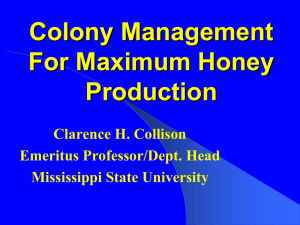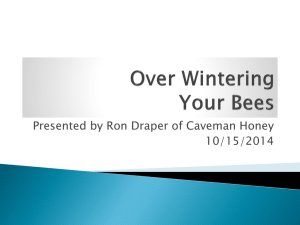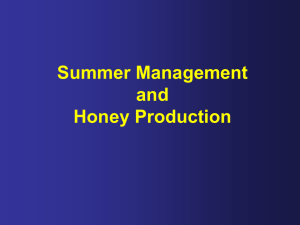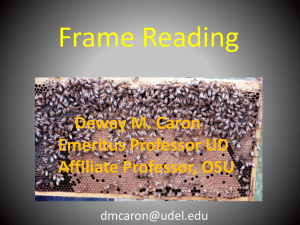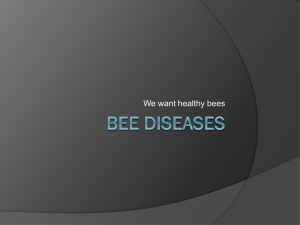Seasonal Management Presentation.
advertisement
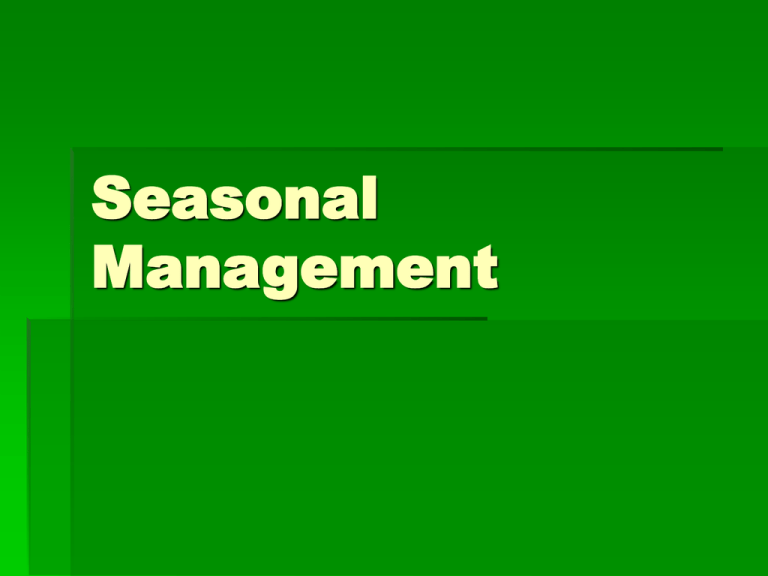
Seasonal Management The Beekeeping Year August Remove honey & treat for Varroa September/October Feed colony and remove Varroa strips Nov./Dec./Jan. Protect from mice & woodpeckers, occasional checks for damage and sufficient stores Feb./March Check for sufficient stores and consider feeding to stimulate egg laying March/April First full inspection, remove mouse guards. Replace old brood combs. Check for disease and ensure queen is marked (and clipped) May Swarm control, routine inspections, add supers June Swarm control and check colony for major build up July Add supers as the honey comes in Colony Population through the year 60000 Brood Adults 50000 40000 30000 20000 10000 0 D N r be em ec r be em ov er ob ct O r be em pt Se h st gu Au ly Ju ne Ju ay M ri l Ap c ar M ry ua br Fe y ar nu Ja The beekeeping year will vary In different regions Sources of honey Climate Annual cycle linked to flowering times! Seasons illustrated may vary by at least a month Courtesy of Google Images Apiary 2 Date 2000 Q QC 4/3 x X 1/4 x X 22/4 B 7/5 Colony 4 Queen bred from Apiary 1 Colony 1 in 1999 Brood Stores Room Health Varroa Temper Feed Health Supers Weather Notes 5 5 l 10 1 LS 0 S, 15 Removed mouse guard 5 5 l 10 1 LS +1 S, 17 Replaced floor board with varroa floor X e 4 10 5 9 0 +2 C, 19 Roof needs repainting X e 7 25 5 200 10 0 -1 S, 21 Cut grass under hive e CB 200 Bees cluster to keep warm Use honey and shiver to generate heat Wind, frost pockets Mouse guards Protection (woodpeckers) Check food stores Feed if neccessary Remove and store empty supers Complete varroa treatment Check for other diseases Move old & damaged frames to side Protect from mice and woodpeckers Ensure hive is weatherproof & secure 30,000 workers 1 queen No drones Season Objective: September / October / November Autumn: Disease & Pest free colony with young queen & sufficent stores for winter Forage & Colony Cycle key points: Disease control Main Crop finished unless preparing for Ling Heather. Late forage from Balsam & Ivy Colony size diminshing, maximise & protect last broods for winter stock Supers removal of Honey for extraction replace for cleaning, on same hive Store drawn supers and protect from Wax moth eg. Fumigation, freezing and seal Brood Check for stores & plan for feeding regimen NBFrame ~ 2.25 kg (5Lb) Check for Disease: Foul Brood Take samples for Acarine & Nosema Hygenic characteristics of colony Check size of colony & estimate size (laypattern) for entering winter Varroa count (>3 /day) & begin treatment (chemical) Continue feed in to min of 16kg and/or if Ivy nectar not desired Add super for stores if egg laying persists Super frame ~ 1.1kg honey Nosema Tx in Syrup feed Queen consider uniting or reducing to nucleus if size not adequate i.e. 9 frames of bees Continue with varroa Tx min 6 weeks Assess quality: laying rate & pattern , temperament Age; > 2 years consider replacement or moving to nucleus for breeding stock Ensure Queen is marked & in good condition Pests sdfoster 27/11/09 Protect against Robbing, reduce entrance size Feed in Evenings if possible Mouseguards Robustness of Hive stand Tie down Hives if exposed position re winds or large mammals remove landing board (birds_ Wire netting/plastic if woodpeckers an issue Ventilate: Crown board spacers, mesh floor (after Thymol Tx), remove dummy boards - to avoid growth of mould Bees cluster to keep warm Use honey and shiver to generate heat Wind, frost pockets Mouse guards Protection (woodpeckers) Flying bees – check for staining Heft hive – check stores Winter Varroa treatment Repair damaged hive components Observe outside for damage Ensure entrance not blocked Bees / Snow 10,000 workers 1 queen No drones December / January Objective: Hives remain in intact and undisturbed Plan for Spring & Summer Colony management No forage Protect and maintain Queen starts laying and brood begins to increase as days lenghten Stores: check later on by weight/hefting only Maintain ventilation: removal of snow from entrance Monitor varroa: if > 8 mites / day Consider oxalic / lactic acid Tx Clean: base/plinth of hive debris and dead bees Apiary : removal of weeds , cut back Summer growth sdfoster 27/11/09 Colony Population through the year 60000 Brood Adults 50000 40000 30000 20000 10000 0 er mb ce De er mb ve No er tob Oc r be em pt Se h st gu Au ly Ju ne Ju y Ma ri l Ap rc Ma y ry ua br Fe ar nu Ja Colony increases rapidly First inspection – Brood issues Monitor varroa levels Swarm control -1 week inspections 40,000 workers 1 queen* 400 drones February / March Quick inspection 5 mins. max Stores OK Queenright & laying Sufficient adult bees Remove mouse guard Feed candy & pollen, if required Plan the season ahead Early Spring: February / March Objective: Build Colony for Spring flow in April Forage & Colony: Rapid increase in demand but forage sparse Nectar in March sparse Dandelion, Sycamore, Pollen imports for brood , snowdrop, crocus, willow, hazel yew Watch stores carefully as more brood than adults in March danger of chilled brood and brood diseases as adults stretched as minimum population of adults in February Stores: Brood rearing and lack of income quickly diminishes Stimulative feeding 50/50 ( they need water) Protein patties if area short on pollen Brood Box:Count varroa > 2/day action dusting, exomite, bayvarol Brood comb change: Bailey or Shook swarm, Clean floor / move to mesh floor ( if not already on sample for nosema , check entrance for signes of diarrhoea Brood comb change / Sufficient space for laying - remove old stores as necessary danger of chilled or chalk brood balance with need for mesh floor & varroa control remove mouseguard and winter ventilation return dummy boards - open crown board repairs to boxes as necessary Queen: marked & condition consistent build up of brood- record/monitor weekly consider replacing as necesary Colony increases rapidly Monitor varroa levels Treat if required First inspection Shirt sleeve weather! Ribes in flower Ensure adequate equipment for swarm control 30,000 workers 1 queen 400 drones Late Spring: April / May Objective: Collect early flow & watch for swarming Forage & Colony cycle: OSR management, Sufficient room for first big flow Hawthorn , blackthorn, chestnut, Topfruit, currants, gooseberry, bluebells, Bee Population rising rapidly potential for varroa to get out of control Adult bees and Brood in equal amounts end of April Stores: Queen excluder and add 1 st super preference for over supering Extract & return supers after flow & feed if necessary monitor sources of nectar for quantity & type eg: rape, quick granulation Brood Box:Sufficient room to lay Monitor carefully for signs of swarming i.e. egg laying rate, Drones, Queen size, Q cups & cells Identify reasons for poor build up in strength add another half (super) or full brood box Disease: watch the Varroa count > 1 / day Drone brood removal & count varroa Icing sugar (& mesh floor if not done) Queen: Build up as expected (ex disease) if not plan to requeen Similarly age of Queen may demand plans for replacement Queen rearing procedures begin May possibly in conjunction with swarm control. Pests: Cattle stock released for outside grazing Inquisitive Humans Add supers Under / Over Check for queen cells Combine small healthy colonies Many bees = excess honey Ensure hives are bee tight Up to 60,000 workers 1 queen Up to 1000 drones Loss of bees Loss of honey Nuisance to neighbours Most swarms left in wild are doomed Many bees = excess honey crop Remove crop in early August to 70,000 workers Ensure hives are bee-tight Up 1 queen Robbing by bees and waspsUp to 1000 drones Extract the honey and store Summer: June / July / August Objective: Collect maximise main foraging flow inforce July in June to collect main summer flow Forage & Colony Cycle: June gap n/s in Twickenham due to Limes & Bramble often a steady income if weather OK but check ! Summer vegetables, herbs, clover & meadow plants (weeds) Adult Bee population peaks at end of June Brood peaks early/ mid June Stores: watch out for stores in June if there is any gap in flowering or bad weather super carefully, under super and adjust frame spacing to maximise load but check for overcrowding remove for extraction as water content allows Brood box:maintain inspections for swarming signs Manage brood space combs, add space, remove pollen and Honey filled combs as necessary unite smaller colonies in June to maximise foraging force in July Disease: Potential for massive varroa build up with increase in brood Varroa Integrated Pest management of Varroa Control at several points of the year makes it harder for the mite population to reach harmful levels • Use of management methods can reduce the need for varroacides • Using two or more unrelated varroacides will delay the development of mite resistance • Control strategies can be easily altered to reflect changing infestation levels Bee Brood & Varroa populations Integrated Pest management Treatments for Varroosis Icing Sugar Dusting bees with icing sugar Apiguard Tray of Apiguard with removable foil lid Pyrethroids Inserting Apistan strip Oxalic Acid Narrow eke 50 ml Syringe with polythene tube extension and protective sleeve Monitoring varroa Keeping Bees Livestock not totally wild Spring and Summer Busy times, weekly inspections Affects your holiday plans Much that an go wrong Manipulation skills Disease knowledge Plants & Forage
